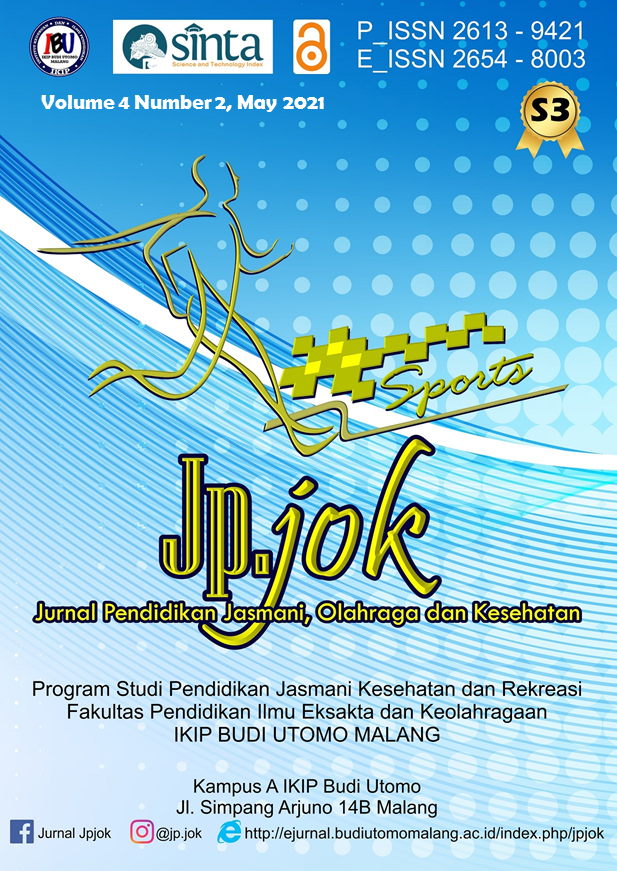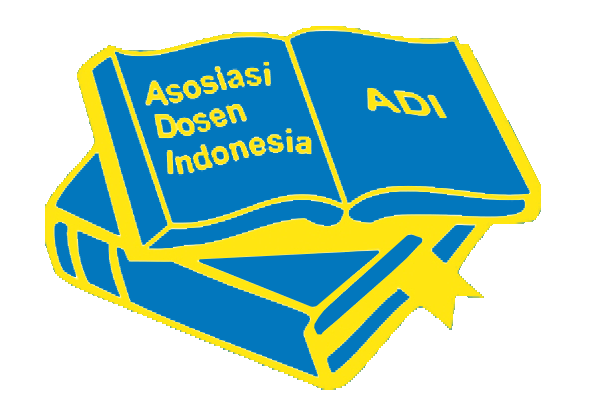Effectiveness and Interactivity on the Use of Virtual Learning Environment (VLE) in Scouting Course
Abstract
This study aims at determining university students’ perceptions on the use of Virtual Learning Environment (VLE) in Scouting Course, specifically focusing on the learning effectiveness and interactivity aspects. VLE based learning has been implemented in the even semester of 2020 during the pandemic of Covid-19. This descriptive qualitative study took 40 students of Physical Education, Health, and Recreation Study Program of IKIP Budi Utomo Malang as the research sample. The results of the questionnaire analysis showed positive perception from the students in regard to Scouting Course using VLE, seen from the aspects of learning effectiveness (76.2%) and learning interactivity (80.4%). However, there were some challenges in achieving a more conducive virtual learning environment. For instance, the unstable network conditions, lack of students' initial knowledge of ICT, incompatible devices with the default system of VLE application, and one-way learning (predominantly assignments). Nevertheless, further research on the effectiveness of other VLE applications and student learning strategies are suggested.
References
Al-Busaidi, K. A., & Al-Shihi, H. (2012). Key factors to instructors’ satisfaction of learning management systems in blended learning. Journal of Computing in Higher Education, 24(1), 18–39. https://doi.org/10.1007/s12528-011-9051-x
Ali, I. T. (2013). Implementasi Konsep Interaktifitas Pada Sistem Pembelajaran Jarak Jauh Berbasis Web Multimedia. Jurnal Teknik Elektro, 12(1), 1–6.
Anggraeni, A. (2014). Using E-Learning to Support Learning and Teaching Language. ELTIN Journal, 2(1), 9–16.
Arikunto, S. (2010). Prosedur Penelitian: Suatu Pendekatan Praktik. Edisi Revisi. Jakarta: Rineka Cipta.
Awang, H., Aji, Z. M., Rozaini, W., Sheik, B., Sintok, M. C., & Nasir, A. A. (2019). Virtual Learning Environment ( VLE ) Implementation Strategy : An Analysis of Practicality for Google Classroom Implementation in Malaysian Schools, Journal of Educational Research and Indigeneous Studies 2(1), 1-16.
Chaeruman, U. A. (2017). Alur Belajar: Meningkatkan Interaktivitas Pembelajaran Daring. Seminar & Lokakarya Pembelajaran Daring Di Perguruan Tinggi, September, 1–10.
Choeda, T. P., Dupka, D., & Zander, P.-O. (2016). The state of Integration of the Virtual Learning Environment and ICT into the pedagogy of the Royal University of Bhutan: A descriptive study. International Journal of Education & Development Using Information & Communication Technology, 12(1), 71–88.
Damanik, S. A., Damanik, S., Suharta, A., & Irfan, M. (2017). Pengaruh Pendidikan Kepramukaan Terhadap Kedisiplinan Mahasiswa Pendidikan Jasmani , Kesehatan dan Rekreasi FIK UNIMED. 16(2), 68–74.
Ile, D. (2017). Impact of Implementing a Virtual Learning Environment (VLE) in the EFL Classroom. 3, 479–498. https://doi.org/10.17533/udea.ikala.v22n03a07
Inah, E. N. (2015). Peran Komunikasi Dalam Interaksi Guru Dan Siswa. Al-Ta’dib, 8(2), 150–167.
Julaeha, S. (2011). Virtual Learning: Pemanfaatan Teknologi Informasi Dan Komunikasi Untuk Meningkatkan Kualitas Pembelajaran. Majalah Ilmiah Pembelajaran, 7(2), 94–102.
Marsiding, Z. (2021). Efektifitas Penggunaan Media Zoom Terhadap Pembelajaran Pada Masa Pandemi Covid-19. Jurnal Ilmiah Pranata Edu, 2(1), 33–39. https://doi.org/10.36090/jipe.v2i1.931
Maulana, H. A., & Hamidi, M. (2020). Persepsi Mahasiswa terhadap Pembelajaran Daring pada Mata Kuliah Praktik di Pendidikan Vokasi. Equilibrium: Jurnal Pendidikan, 8(2), 224–231. https://doi.org/10.26618/equilibrium.v8i2.3443
Mosquera, L. H. (2017). Impact of implementing a virtual learning environment (VLE) in the EFL classroom. Ikala. 479-498. https://doi.org/10.17533/udea.ikala.v22n03a07
Shahabadi, M. M., & Uplane, M. (2015). Synchronous and Asynchronous e-learning Styles and Academic Performance of e-learners. Procedia - Social and Behavioral Sciences. 129-138. https://doi.org/10.1016/j.sbspro.2015.01.453
Sudiana, R., & Fatah, A. (2017). Kemandirian Belajar Mahasiswa Melalui Pembelajaran Berbasis Virtual Class. Jurnal Penelitian Dan Pembelajaran Matematika, 10(1), 74–80.
Sumarmo, U. (2004). Kemandirian Belajar: Apa, Mengapa, dan Bagaimana dikembangkan pada Peserta Didik. Makalah pada Seminar Tingkat Nasional. FPMIPA UNY, 1-9.
Yusny, R., & Ibnu Yasa, G. (2019). Mengembangkan (Pembelajaran) Blended Learning dengan Sistem Lingkungan Pembelajaran Virtual (VLE) di PTKIN. Jurnal Ilmiah Islam Futura, 19(1) 103-127. https://doi.org/10.22373/jiif.v19i1.3707
Copyright (c) 2021 Jp.jok (Jurnal Pendidikan Jasmani, Olahraga dan Kesehatan)

This work is licensed under a Creative Commons Attribution-ShareAlike 4.0 International License.
Authors retain copyright and grant the journal right of first publication with the work simultaneously licensed under a Creative Commons Attribution 4.0 International License that allows others to share the work with an acknowledgement of the work's authorship and initial publication in this journal.





.png)






